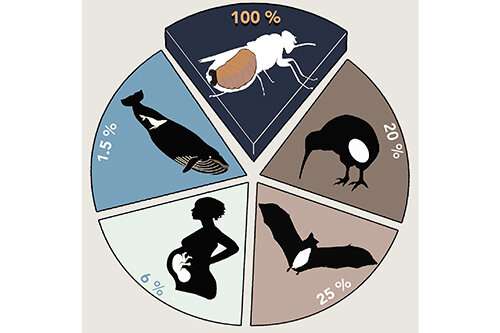Big babies, little mothers: Tsetse flies show extreme mothering

The tsetse fly is an exception to the almost universal law of nature that babies are born smaller than their mothers.
In an article published in BioEssays, Dr. Sinead English and Dr. Antoine Barreaux from the University of Bristol's School of Biological Sciences, together with colleagues at the Liverpool School of Tropical Medicine, and the Universities of Greenwich, Stellenbosch and California Riverside, explore the extreme reproductive strategy of tsetse flies—which sees mothers give birth to young that astoundingly are 100 percent of their body size.
Across most of the animal kingdom, offspring are born smaller than their parents. Surprisingly, several insect families, including tsetse, are exceptions to this rule. This amazing feat is possible thanks to two main factors. First, tsetse feed exclusively on protein-rich blood and can consume more than twice their body weight every few days. Second, tsetse do not have the same constraint as mammals such as a fixed pelvic girdle, which prevents birthing of enormous babies.
Producing large offspring does, however, have a consequence that egg-laying insects do not face—female tsetse flies can birth only one baby at a time, at relatively long intervals. This results in a slow life history, in which the females must be continually pregnant and long-lived, if the number of offspring produced is to be enough to sustain the species.
Dr. Lee Haines, lead author on the study, said: "The thought of a female giving birth to a single offspring that weighs more than she does is difficult to wrap your head around. Since we are familiar with human babies, which weigh ~6% of the mother's pre-pregnancy weight, this feat is unthinkable. Now, imagine giving birth to a massive baby every ten days… for the rest of your life. This tremendous maternal investment raises the question of how natural selection could produce this seemingly impossible capacity. The unusual method of reproduction also carries enormous ramifications for tsetse biology, survival and the control of vector populations."
Burrowing for knowlegde is a short documentary about the BBSRC/RS-funded project led by Professor Steve Torr at Liverpool School of Tropical Medicine and Dr. Sinead English at the University of Bristol.
Tsetse are not only fascinating from a biological perspective, but they are also a serious public health and veterinary threat because they transmit the micro-organisms responsible for the fatal human and animal diseases called African trypanosomiases. The essay discusses how the life history of the tsetse and its strange reproductive strategy directly influence the type of vector control interventions people can use to reduce fly populations and control the disease.
Since tsetse larvae remain protected within their mother's uterus and the pupae are hidden in the soil, controlling tsetse populations is unfortunately restricted to targeting only adult flies. Thankfully, the tsetse's slow breeding cycle means that you only need to kill a few percent of the adult female flies per day to eradicate any tsetse population. Currently, insecticide applied to cattle and artificial host-like baits, such as "tiny targets" are used successfully to control tsetse populations in disease-endemic areas. Other vector control strategies, like sterile insect techniques and microbiome-mediated control strategies, can be more challenging to implement due to the flies' specialized reproductive strategy.
More information: Lee R. Haines et al. Big Baby, Little Mother: Tsetse Flies Are Exceptions to the Juvenile Small Size Principle, BioEssays (2020). DOI: 10.1002/bies.202000049
Journal information: BioEssays
Provided by University of Bristol



















